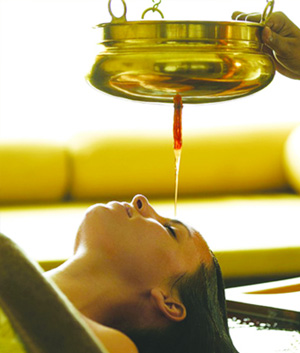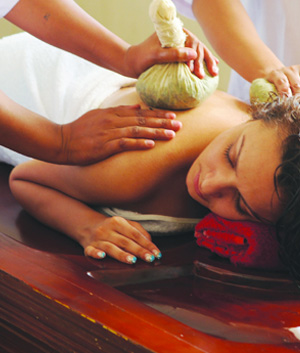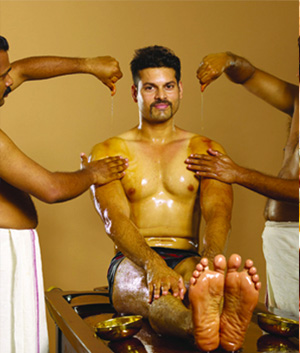Ayurveda

Composed of two Sanskrit words “Ayur” and “Veda”,In Sanskrit, Ayurveda means Knowledge of living. Ayurveda is considered as a boon given by the Gods to mankind. Ayurveda aims at creating a balance in the mind and body. Its principles help in the prevention of illness rather than curing it, and thus making a person’s life long, healthy and joyful one. Ayurveda has very strong roots in Kerala and this land of diversity is very famous for its ayurvedic treatments.

1. Abhyangam
Abhyangam is a therapeutic method in Ayurveda. It comprises systematic and organized body massages which aims in healing. In this method, medicated oils are used for massaging. It destroys vata and softens, lubricates, and removes reserved wastes.

2. Dhara
Dhara is a method in which herbal oils, medicated milk, buttermilk, etc. are poured on the forehead for 45 minutes, in a specific manner. It cures insomnia, vata dominated diseases, mental disorders, neurasthenia, memory loss and certain skin diseases.

3. Kizhi
Kizhi therapy which uses heated herbs and medicinal oils are tied in cloth bags and applied on the part to be cured. It is quite effective in curing problems like backache, knee pain, joint pain, neck pain, low blood circulation and Neuro vascular disorders.

4. Navarakizhi
Navarakizhi is one of the customary treatment in Astavaidya custom of Kerala. It is a sweat inducing massage treatment which is effective in treating rheumatism, joint and muscle pains, sciatica, slipped discs, high blood pressure, high cholesterol, and various sexual disorders.

5. Pizhichil
In Pizhichil therapy, warm medicated oil is squeezed over the patient’s body. Pizhichil is a distinctive form of treatment which is a combination of oil massage and heat treatment. This therapy is used to treat blood circulation, nourishes muscles, nerve tissues and improves sexual ability.

6. Nasyam
Nasyam is one among the five panchakarma therapies ,in which herbal juice or medicated oil are applied through the nostrils. It works on disorders of ear, nose and throat.It is highly effective for certain kinds of Headaches, Sinus problems,Epilepsy and Eye diseases.
Yoga

The basic assumption of Yoga is that the body and the mind are part of one continuum of existence, the mind being more subtle than the body. This is the foundation of the yogic view of health. The interaction of body and mind is the central concern of the entire science. It is believed that as the body and mind are brought into balance and health, the individual will be able to perceive his true nature; this will allow life to be lived more freely and spontaneously. Yoga first attempts to reach the mind, the place where health begins, for mental choices strongly affect the health of the body. Choices of food, types of exercise, which thoughts to think, etc. all affect the body. As practiced traditionally in India, Yoga includes a set of ethical imperatives and moral precepts, including diet, exercise, and meditative aspects. In the West, Yoga focuses primarily on postures (gentle stretching exercises), breathing exercises, and meditation. Yoga is frequently used in modern medicine to enhance health and treat chronic disease as well as stress.
Yoga for Stress-free life
In the midst of our modern world characterized by daily stress, fatigue, and pollution, more and more people are seeking that elusive sense of relaxation and inward awareness. We are often depressed, tired, and an easy victims of disease. Though the practice of Yoga is closely associated with ancient texts, beliefs, and values, it also yields benefits useful for people’s practical daily lives.